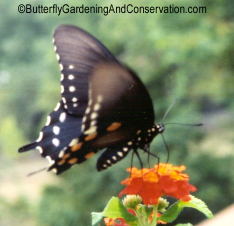|


 | Introduction |
| Introduction |
| Butterfly Gardening |
 Swallowtails
Swallowtails
Sulfurs/Whites
Brushfooted
Little
Snout
 Host
Host
Nectar

T-shirts
Mugs
Magnets
Clocks
Tote Bags
Framed Tiles
Notebooks
Postcards
Light Switch Covers
Tile Coasters
 Books
Books
Web Sites

|

Adult Pipevine Swallowtail
nectaring at
Lantana.
Pipevine Swallowtails have black wings with blue in them with a wingspan of 2.5 - 4 inches.
Females have less blue and bigger pale spots on their wings than males. Habitat is mostly
brushy or wooded places. Their range includes most of the Eastern US, the southwest and
into Mexico.
Pipevine Swallowtail Host Plants
The host plant used by Pipevine Swallowtails are all of the family Aristolochiaceae (pipevine).
This includes
Aristolochia tomentosa, Aristolochia californica, serpentaria, durior, longiflora,
reticulata. Aristolochia californica is used by
some populations in California.
Females will lay eggs on Aristolochia elegans, but caterpillars will die eating it.
Aristolochia serpentaria and reticulata are small herbs, the rest are vines.
Since Pipevine is poisonous to vertebrates, adult Pipevine butterflies are poisonous
to birds and other predators that might try to eat them.
Because of this Pipevine Swallowtails are mimicked by
Spicebush Swallowtails (Papilio troilus), female
Black Swallowtails (Papilio polyxenes),
black form female
Tiger Swallowtails (Papilio glaucus), female Speyeria diana and female
Limenitis arthemis astyanax.
Pipevine Swallowtail Life Cycle
Pipevine Swallowtail eggs are a reddish/maroon color and laid in groups of up to 20 eggs on
the underside of host plant leaves. I have yet to see any actual eggs on my pipevine, so I don't have
any pictures of them. The caterpillars are black with red/orange colored spikes
all along their bodies.
If fact, I had my pipevine for somewhere between 3 and 5 years before I saw any caterpillars on it and I missed the eggs.
When I found them they were this size already - I think 2nd or 3rd instar:

They were also on the underside of a leaf, so they weren't that easy to find.
Here some are again, some time after the above picture:

Here is one around the 4th instar with a ruler next to it to help gauge its size:

Here's one getting ready to molt. You can see its head capsule doesn't quite fit right. (If you click on the image you
can see a bigger version that is a little more clear.)

Here's a 5th instar next to a ruler to show how much bigger they got:

Here's another picture from a different perspective - you can see its head better:

I noticed after a while that mine would tend to crawl off the pipevine at night - I saw them crawling up
the side of the house a few times. There are about 4 or 5 in the picture below - notice the one in the upper
right, its pretty far away from the plant:

As with most butterfly caterpillars, sometimes you first find them on a plant by finding a bunch of their
frass first. In the following picture you can see a bunch that was on one of the pipevine leaves:
(If you click on the picture, you can see a bigger version)

Pipevine Swallowtail pupa are very pretty. If the lighting is right you can see purples, oranges and other
colors in them. The following two pictures of pupa are taken from the side and the front:


Adults have black wings with blue in them with a wingspan of 2.5 - 4 inches.
Females have less blue and bigger pale spots on their wings than males.
Their bodies also have some blue on them. They tend to hover next to flowers when getting nectar
rather than landing and resting on the plant.

|
|
This adult seemed to prefer the red/orange
Lantana,
shown in picture, and other
red flowers over other flowers.
|

|

|
|
These two
pictures were the best I could get of adults with their wings open.
|
Butterfly Gardening Home |
Butterfly Gardening Articles |
Butterfly Species |
Plants |
Butterfly and Gardening Shopping |
T-shirts |
Mugs |
Magnets |
Clocks |
Tote Bags |
Framed Tiles |
Notebooks |
Postcards |
Light Switch Covers |
Tile Coasters |
Calendars |
Butterfly Calendars |
Resources |
Contact |
Blog |
[old blog] |
© 2003 - 2026 ButterflyGardeningAndConservation.com
Today is: 9 January 2026, 4:26 pm |


